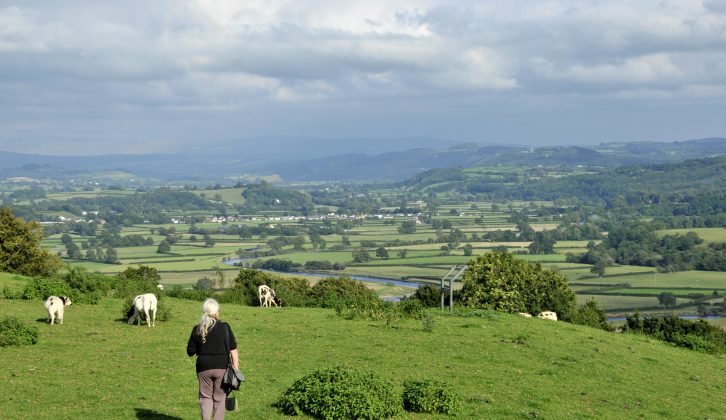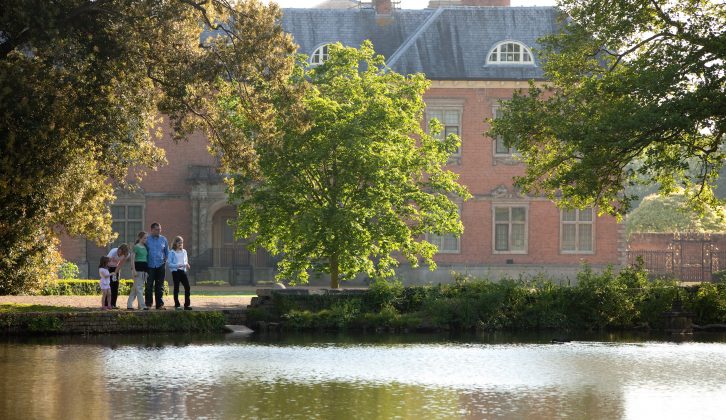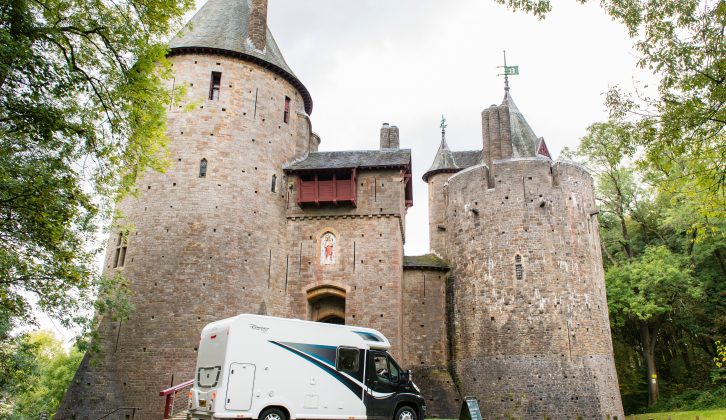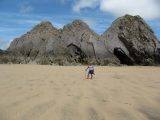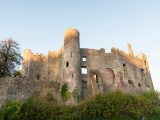South Wales is a land of contrasts, incorporating remote uplands, lush green valleys, industrial heritage, internationally recognised coastal areas, some of the best beaches in the world – and a capital city. A motorhome tour in South Wales can take full advantage of these distinctive landscapes whether looking for the ideal seaside holiday, retreat and seclusion or city life.
Wondering where to stay when you embark on a tour of the beautiful region? Then check out our guide to the best motorhome sites in Wales too!
The Cambrian Mountains
The Cambrian Mountains are the backbone of southern Wales, beginning at the foot of Snowdonia National Park in North Wales. One of the least populated areas of the country, the mountains run north to south, crossing the border of two counties – Powys (Wales’ largest county) and Ceredigion. They are immensely important as the source of both the Rivers Wye and Severn. Pumlumon, at the northernmost end of the Cambrian Mountains, is a massif with the five highest peaks in the range. The massif offers superb walking territory for experienced walkers, with views of the Welsh Marches to the east and Ceredigion Heritage Coast to the west.
Perhaps as expected, the strip of land between the mountains and the coast is a mass of tiny streams and rivers, draining off the hills towards the sea. Two such rivers are the Mynach and the Rheidol. They meet at Devil’s Bridge, 12 miles east of Aberystwyth, creating a spectacular 300-foot waterfall, Devil’s Bridge Falls. Devil’s Bridge contains three bridges, one stacked on top of the other.

Of the towns on the coast, Borth, Aberaeron and, further south, New Quay, all support Blue-Flag beaches while Aberystwyth houses the National Library of Wales, an important institution for finding ancestry or discovering more of Wales’ significant history. The coastline borders the vast Cardigan Bay, where you can expect to see dolphins on a sightseeing boat trip departing from New Quay, operated by the Cardigan Bay Marine Wildlife Centre.
The Welsh Marches
To the east of the Cambrian Mountains are the Welsh Marches, a historic border area alongside the English counties of Shropshire and Herefordshire. A land of rugged moorland, forested hills and river valleys, it is not densely populated either and is filled with the medieval haunts of its past in the form of ruined castles and defensive outposts.
It is great territory for walking, with two long distance national trails crossing the area. Offa’s Dyke Path runs north to south, while Glyndwr’s Way, named after the 15th century Welsh warrior and self-proclaimed Prince of Wales, crosses east to west – or rather west to east and back again between Welshpool, Machynlleth and Knighton. The two trails meet on the border at Knighton, where you can also learn more of the 12th-century King Offa at the Offa’s Dyke Centre.
Bringing Welsh history slightly more up to date, the Elan Valley Estate, west of Rhayader, comprises five reservoirs. They were constructed at the end of the 19th century to provide water for the city of Birmingham; Elan, the settlement that was created at the time to house the workers building the dams, is the only purpose-built Arts and Crafts village in Wales. The estate today offers 70 square miles of marvellous countryside for walkers and cyclists.
Brecon Beacons National Park

South of the Cambrian Mountains is the Brecon Beacons National Park. The park actually covers four mountain ranges, with the Black Mountains easternmost. Hay Bluff and Sugar Loaf are two of the most recognisable peaks within this range. The Brecon Beacons lie in the centre of the National Park, its highest peak being Pen y Fan; the large visitor centre providing information on the Park, and the activities that can be done across this wide stretch of moorland, is situated off the A470, just south of Brecon.
The remainder of the National Park is made up of Fforest Fawr and Black Mountain. Running along the northern edge of the Park is the River Usk. A beautiful river valley, it flows through the market town of Brecon – famed for its farmer’s market – and Abergavenny, also a foodie town with its own annual food festival on the eastern edge of the National Park. It’s possible to take narrowboat day trips on the neighbouring Usk Canal.

The Brecon Beacons National Park has also gained Dark Sky Reserve status. Only a handful of places in the world have received such recognition, with numerous stargazing opportunities and activities offered at locations throughout the Park.
At the northeastern tip of the National Park is the gorgeous little town of Hay-on-Wye. A bookworm’s dream town, it’s difficult not to fall in love with the place – providing you like books, although it’s also a great starting point for walks into the surrounding hills. Hay is the self-made capital of books, with its annual Hay Festival a major international literary event. Even if you don’t venture into a bookshop, however, there are numerous little cafés and restaurants plus the ruined Hay Castle right in the centre of town.
The Wye Valley

The River Wye flows through the town before it turns south, creating the wriggling border with England. Here it becomes a part of the Wye Valley Area of Outstanding Natural Beauty, as it flows between forested cliffs of ash, beech and oak. The Wye is the first river in Britain to be designated as an SSSI (Site of Special Scientific Interest) along its entire length.
Prior to its entry into the River Severn at racing post Chepstow, the Wye flows past Tintern Abbey. Created by Cistercian monks in 1131, the abbey succumbed under Henry VIII’s Dissolution of the Monasteries. The riverside ruins have provided much inspiration for creative minds such as poet William Wordsworth and painter JMW Turner.
Welsh Valleys

West of the Wye Valley are some altogether different valleys, though no less striking. The 17 Welsh Valleys that run roughly north to south below the Brecon Beacons National Park became world famous in previous centuries for being at the very heart of the Industrial Revolution.
Once employing hundreds of thousands of workers to mine for ‘black gold’, the Welsh Valleys was an industrial landscape with more than 500 collieries operating at the coal mining peak in 1913, together with Iron foundries and steel making. The Rhondda Valley is, perhaps, the most well known of all, but it is Blaenavon to the east of the area that is designated as a World Heritage Site for its contribution to an industrial past over three centuries.
Today, the steep sided valleys that were once scarred by industry are green again and forests like Cwmcarn and Afan Forest Park offer mountain bike trails with a further 250 miles of off-road cycle trails taking up disused railways and tracks.
Attractions in the area include Caerphilly Castle, the second largest castle (after Windsor) in Britain, the Rhondda Heritage Park and Waterfalls Country, an area of numerous water features. Visit the Waterfalls Centre at Pontneddfechan (at the head of the Vale of Neath) to find out about the geology and mythology of the main rivers in the area and take a wander to Sgwd yr Eira (translated as Snowfall), where you can walk behind the waterfall.
For some of the best views of the Welsh Valleys, drive along the B4560 north of Ebbw Vale, or climb the Twmbarlwm Iron-Age Hillfort near Cwmcarn for 360˚ vistas.
Cardiff – capital of Wales

At the foot of the Welsh Valleys, stretching out into the Severn Estuary is the capital of Wales, Cardiff. It’s an easy place to visit during a motorhome tour, with a campsite right in the centre of the city and within walking distance of the dominant Cardiff Castle and all the main shopping streets. Cardiff’s Principality Stadium is also within walking distance while the Sophia Fields Stadium, home to Glamorgan Cricket, is next door to the campsite.

A little further afield, at the regenerated Cardiff Bay, you can follow all things Darlek and Tardis-like as the television show Doctor Who is filmed at studios here. Cardiff is stuffed full of museums and art galleries, too, but on the outskirts is the very special St Fagan’s National Museum of History. An open-air museum, here are 40 original buildings from different parts of Wales illustrating a fascinating social history of the country.
The Mumbles and Gower Peninsula
Wales’ other main city, also on the coast west of Cardiff, is Swansea. Its coastal location, with the sweeping Swansea Bay, is not lost on locals; the National Waterfront Museum celebrates the country’s industrial and maritime history dating back to the 1800s.

To the west of Swansea is The Mumbles, a lively seaside town that serves up great seafood. The Mumbles juts out as part of the Gower Peninsula. As Britain’s first ever Area of Outstanding Natural Beauty, it’s not difficult to understand why. The area has some of the best beaches in the world – officially – and they are generally quiet with the whole area free of thronging crowds.
Three Cliffs Bay, Rhossili Bay, Oxwich Bay and Broughton Bay are some of the best beaches, while a visit to the tiny village of Rhossili at the far end of the peninsula is a must. Walk up on to Rhossili Downs for outstanding views, or wait for the causeway to appear and walk, carefully, across to the tidal island of Worm’s Head, taking account of the tides.
Carmarthenshire and Pembrokeshire

West of the Gower is Carmarthenshire, a lesser-known tourist spot with most visitors passing straight through for the more popular Pembrokeshire, but nonetheless a great place for a motorhome tour, with lots of campsites in the area. There are no cities in the county, ‘just’ the town of Carmarthen, which happens to lay claim as the oldest town in Wales. To the south of the county is the seaside town of Llandeilo and the Llanelli Wetlands Centre. The Millennium Coastal Park, with a purpose-built 12-mile cycle path, connects the Wetlands Centre and Pembrey Country Park to the west, an unspoilt 500-acres edged by an unbroken eight-mile beach.

East of Carmarthen, and close to the westerly limits of the Brecon Beacons National Park is the tiny town of Llandeilo. On the banks of the River Towy, the pretty town has a reputation for being the fashionable place to go for food and quaint shops. Nearby, there’s a choice of two gardens, Aberglasney, a restored 15th Century masterpiece or the National Botanic Garden of Wales, a modern masterpiece with a very, very large greenhouse.
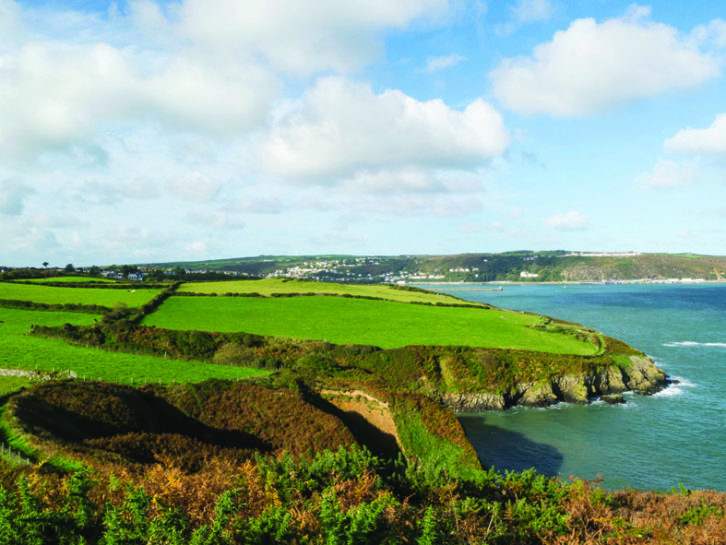
Pembrokeshire is the jewel of West Wales. One third of the county is covered by the Pembrokeshire Coast National Park – that’s the entire coastal strip heading two miles inland – the only national park in the country to do so. The Pembrokeshire Coast National Trail follows the coastline, too, where you can expect to see steep limestone cliffs, volcanic headlands and deep glacial valleys. A year-round Coastal Bus Service is specially designed to assist walkers on the Trail, although there are lots of opportunities for circular walks, too.

In the southeast of the county is Tenby, considered one of the prettiest towns in Wales. It’s a medieval walled town with a maze of narrow little streets, and more ‘recent’ colourful Georgian townhouses. There are three Blue-Flag beaches and the opportunity to take a boat trip to Caldey Island, run by Cistercian monks that live in the 12thcentury priory there.

Further west is the charming seaside village of Manorbier, which was a popular haunt with writers such as George Bernard Shaw and Virginia Woolf. There’s a very picturesque castle here, or otherwise move on towards St Govan’s Head to see the tiny clifftop chapel.

As the boats leave Pembroke Dock, they depart from the start of a secret, inland waterway, the several-pronged Daugleddau Estuary that penetrates deep into the countryside. It’s a spectacular place of immense natural beauty and a great place from which to spot native wildlife. But then so are the islands of Skokholm, Skomer and Ramsey, all off the west coast of Pembrokeshire. All three are classified as major nature reserves (Ramsey is an RSPB reserve) with native and migrating birds visiting together with the chance of seeing a grey seal. Sea Safaris depart from Martin’s Haven.
Around the extensive St Bride’s Bay, with a plentiful supply of individual coves and beaches, is St David’s, the UK’s smallest city. The 12th century cathedral dominates what is, in size, a large village. Named after the patron saint of Wales, the city endears itself to all who visit, though make time to stop off at the nearby Blue-Flag Whitesand Bay.
It’s possible to see porpoises and bottlenose dolphins off the coast from St David’s Head to Strumble Head further north. Here, the national park turns inland to cover the Preseli Mountains. The highest point is Foel Cwmcerwyn at 1,758 feet and the entire upland area is filled with the evidence of Celtic roots.
Things to do

1.On your motorhome tour of South Wales, why not go stargazing in the Brecon Beacons National Park. On a clear night you can see the Milky Way, major constellations, bright nebulas and meteor showers. As an International Dark Sky Reserve, there are numerous stargazing events that take place throughout the year, often in the presence of an astronomer that will help you to appreciate the night sky.
2.Go deep underground – 300 feet to be precise – at the Big Pit National Coal Museum to discover all about the Welsh mining industry. Visitors descending the mineshaft wear the very same equipment – helmet, cap lamp, belt, battery and ‘self rescuer’ – that were used by miners.

3.Swansea is where author and poet Dylan Thomas was born and raised. The Dylan Thomas Centre, in the city, is a permanent celebration of his life and work. On your motorhome tour you can also visit the Dylan Thomas Boathouse in the tiny village of Laugherne in Carmarthenshire, where Thomas spent the last four years of his life.
4.Visit the medieval walled town of Pembroke, where you can enjoy the impressive Pembroke Castle, birthplace of Henry VII, founder of the Tudor dynasty. A castle moat extends around much of the town.
5.If rugby is simply not your thing, then have a go at Cardiff’s International White Water Centre. There’s family rafting, canoeing and kayaking and even indoor surfing if you don’t want to get wet from the rain!
When to visit

No spring is complete without the annual festivities on the first day of March to celebrate St David’s Day – you’ll find something going on in most Welsh towns, with a big celebration in Cardiff. Neither would Hay-on-Wye be the town that it is without the internationally renowned Hay Festival for literary lovers, held every May.
Rugby fans can, of course, be kept occupied with Six Nations matches in Cardiff between February and April, while walkers should head to the Gower Walking Festival, held during September. And for music lovers, there’s the Brecon Jazz Festival followed by the Green Man Festival, a folk offering, both held in August.
Wales is renowned for its fabulous local produce, too, and this is celebrated throughout the region, whether with Pembrokeshire Fish Week at the end of June, the Cardiff Food and Drink Festival in July or The Big Cheese, Caerphilly’s take on foodie revelry. Though the biggest day in the rural/food calendar is the Royal Welsh Show, held at the national showground in Builth Wells, which takes place in July.
Getting there

The M4 crosses into South Wales north of Bristol, with access from the south west and north via the M5. The M4 travels as far west as Pontarddulais, seven miles west of Swansea, where the A48 picks up to Carmarthen and Pembrokeshire.
Crossings on the two Severn Bridges are no longer tolled. The Severn Bridge (the M48) is best for heading to Chepstow and the Wye Valley while the Prince of Wales Bridge (the M4) is direct to Newport and Cardiff.
The M50, a spur off the M5 near Tewkesbury is a useful alternative route to Monmouth and the Brecon Beacons, with the A40 and A449 dual carriageways providing a, relatively quiet, and very picturesque route.
Motorhome access

The main routes passing through the Brecon Beacons National Park should not cause any problems for motorhomes, as the roads tend to follow the river valleys. There is one significant incline at Bwlch (on the A40 Abergavenny to Brecon road) but this is still passable for coachbuilt and A-Class motorhomes.
The roads across and within the Cambrian Mountains are narrow and steep in places and should be avoided if you’re touring in a large motorhome. Many of the routes in Pembrokeshire are rural and twisty, so extra time should be allowed for journeys here. The best route to reach Pembroke Dock for ferries to Ireland is along the A48 and A477.
Care should also be taken around the Gower Peninsula, where roads are narrow; indeed if you have a coachbuilt, the Gower is best explored on foot or by bike, having left the ‘van at a campsite.
For Cardiff, there are no height restrictions at the East Park and Ride car park for those visiting for the day. However Cardiff Caravan and Camping Park is right in the city centre of Cardiff, close to Cardiff Castle and shopping areas. There are also useful park and ride facilities at Aberystwyth, Carmarthen and Swansea.
One of the most motorhome friendly counties in South Wales is Pembrokeshire, where motorhomes are allowed in council-run car parks, and with some larger bays provided in certain car parks. Where ‘vans take up more than one space, simply purchase additional tickets. Saundersfoot Harbour car park is suitable for campervan parking only, but is a useful place to access the Pembrokeshire Coast Path. There are, however, a handful of car parks within the county with height barriers.
Where to stay

Pick your spot to pitch in South Wales from our annual Top 100 Sites Guide, as voted for by you. The region always does very well in the Awards, with sites such as South Wales Touring Park, near Swansea, and Woodlands Caravan Park regularly featuring. New in the Top 100 Sites for 2022 is Bargoed Farm, overlooking Cardigan Bay.
We’ve also got you covered for the best campsites in Wales with sea views.
Our Practical Motorhome Nightstops Scheme has some great venues to overnight in South Wales, and we’re adding new places all the time. Select, for example, between the Railway Hotel in Carmarthenshire or The Penrhiwgaled Arms, close to Cardigan Bay and the Ceredigion Heritage Coast. You can stay at both venues for just £5 per night. Alternatively, you can stay in the car park of The Seaview Hotel, right on the seafront in Fishguard, for free if you have a meal there.
Local transport links
The lack of specific motorhome parking makes public transport options all the more vital. A useful website to plan journeys by bus or train within South Wales is www.traveline-cymru.info/. There are lots of good, cross-country bus services throughout the Brecon Beacons National Park, or you can catch the T1 (from Cardiff) or T6 (from Swansea) to reach the park.
You’ll also find lots of traffic-free cycle routes within South Wales, especially around the Welsh valleys. Particularly popular is the all-Tarmac, traffic-free 13-mile coastal route, the Millennium Coastal Path, through the Millennium Coastal Park in Carmarthenshire. Don’t forget the Taff Trail, between Brecon and Cardiff, too.
If you liked this… READ THESE:
North Wales: Practical Motorhome Travel Guide
Best campsites in Wales with sea views
Your Tour: Walking the Pembrokeshire Coast Path
If you’ve enjoyed reading this article, why not get the latest news, reviews and features delivered direct to your door or inbox every month. Take advantage of our brilliant Practical Motorhome magazine SUBSCRIBERS’ OFFER and SIGN UP TO OUR NEWSLETTER for regular weekly updates on all things motorhome related.
You'll find some of the best beaches, the finest rivers and the most beautiful scenery in the world



